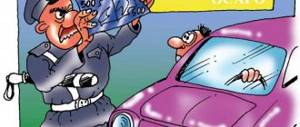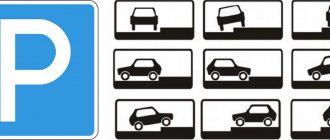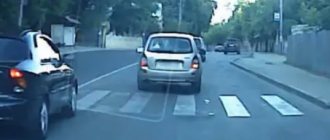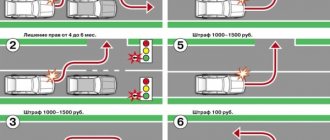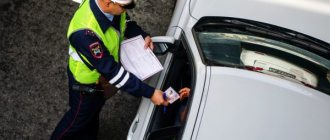Penalty for not having a child seat
The regulatory act of traffic rules, paragraph 22.9, sets out the rules that must be followed when a child is in the car, in the front or rear passenger seat.
The following standards must be observed:
- up to seven years - travel in the back and front seats and with full fixation using a cradle or car seat;
- being in a seat and secured with belts is mandatory, even for short trips;
- for children from 7 years to 12 years, and large children who do not fit in a seat can be transported without a seat only in the rear seats of the car;
- The cradle or chair is selected according to age and weight.
For violation of these rules, an administrative fine is imposed for a child without a chair - 3,000 rubles in all regions, in accordance with Article 12.23 of the Administrative Code.
For leaving a child under 7 years old in the car, the penalty amount is 2,500 rubles for residents of Moscow and St. Petersburg, and 500 rubles for other regions (Clause 1.Article 12.19 of the Administrative Code).
How can a traffic police officer ensure that children are transported correctly?
Numerous tests have proven that conventional seat belts can cause serious injury to small passengers even in minor collisions. This is because they are designed for an average height person, keeping his chest in a static position. For most children, the strap will be kept at neck level. This will not only not keep children in the chair, but can cause damage to the neck and collarbones.
Improper transportation of children
On the other hand, child seats are immediately designed for the safety of young passengers. They are often equipped with their own belts (Isofix), and the main belt of the car secures the seat itself, and not the child in it. It is this measure that allows us to say for sure that injuries are reduced significantly. Even in the event of a serious accident, the chances of a successful outcome remain.
Today, the rules for transporting children are strictly regulated by traffic rules. In particular, the main provisions are enshrined in clause 22.9.
- Firstly, it is immediately stipulated that children under 7 years old can only be transported in child seats. After 7 years, they can sit in a car without a special seat, but only in the back seat. You will need a seat if you are transporting children in the front. The rules then require that these safety devices be used on a child before he reaches 12 years of age.
- Secondly, children under 12 years old cannot carry children on the back of motorcycles.
Important! The original prescriptions changed over time. For example, it is now said that the definition of “other devices” is no longer used. This means that only a special certified seat is suitable for transporting children - and nothing else. So-called boosters (seats without a backrest) can be used after 7 years, and they are equivalent to armchairs. And most models are immediately made in such a way that the backrest can be removed over time, making the design lighter.
We suggest you read: Check traffic police fines online - how to find out the debt on traffic police fines by state. number and driver's license. Checking for unpaid fines by car number and license
The only option inspectors have is a visual inspection. When stopping a vehicle carrying small children, the traffic police officer has every right to find out the age of the small passenger and make sure that the rules for transporting children are not violated.
Important detail! Modern cars are often tinted at the factory. Therefore, the traffic cop may ask you to lower the window.
Advice. It is better not to enter into conflict with a person in the service. A polite request should be answered with politeness. Formally, a traffic police officer has no right to open the doors or lower the car window on his own. But he can conduct a full inspection, even if the car does not cause any suspicion, according to the driver.
When children are transported incorrectly, punishment follows. It’s interesting that sometimes a child restraint is actually present, but a fine is still issued. This happens if the child is not in place. A traffic cop can punish for:
- children are on the laps of other passengers;
- even if the child does not fit in the chair, according to the law, the inspector can issue an order;
- when a child is sitting in a seat, but the seat belt is unfastened or the seat itself is not secured in the car;
- if the rule is not followed: one seat - one child;
- The car is not equipped with seat belts (when there are devices only in the front, children are strictly seated there).
As for the number of regulations, they are imposed on each driver (even when the official transports a group of young passengers at once not according to the rules) in a single amount. However, the peculiarity of the situation is such that the violation must be eliminated immediately. That is, in fact, the traffic cop can impose a second fine if you start driving without eliminating the order.
Traffic police officer
Fine for ordinary people, officials and legal entities
The fine for not having a child seat varies depending on who committed the offense:
| Responsible person | Amount of fine in rubles |
| Driver (Parents, relatives) | 3 000 |
| Officials – educators, teachers, taxi drivers | 25 000 |
| Legal entities – school, taxi company | 100 000 |
It is possible to pay the fine with a 50% discount within 20 days from the date of delivery of the decision to the citizen.
Fine for an unbelted child
In 2007, fines for not having a child seat began to be applied, and warnings began to be issued much earlier. More precisely, they were punished for not having a child restraint in the car when transporting a child.
Important! Later, the rules only became stricter, and from 2021 it is only allowed to use child seats or boosters (if the child is over 7 years old but under 12).
The previously very popular seat belt fasteners (adapters for standard seat belts) will now still attract a fine, since they have not passed mandatory certification by the State Traffic Safety Inspectorate.
Universal transformable chair
If we talk about the punishment for drivers that can be imposed for not having a child seat in the car when transporting children, it is regulated by the Code of Administrative Offences. A measure that can be imposed by a traffic police inspector is a fine. What is the fine for an unbelted child?
The fine for a child without a seat in 2021 is:
- for individuals 3000* rubles;
- officials who control the transportation of one or a group of children are fined more seriously - up to 25,000 rubles*;
- A legal entity may be fined for a child seat of up to 100,000 rubles*.
Accordingly, it becomes clear that the amounts of fines are quite large, which gives full confidence that they can amount to up to 50% of the cost of the chair itself (market average). Therefore, even the most budget models (and they are subject to no less number of safety checks) will already pay for their expenses in just two stops by a traffic cop.
Note! The twenty-day rule applies to this type of punishment. If the offending driver manages to pay within 20 days of receiving the order, he will be given a 50% discount from the state. But if the fine for an unbelted child is repeated, then the full amount is paid.
We invite you to read: Penalty for crossing a solid marking line
By the way, another measure applicable to drivers is when a beloved child is left alone in the car, unattended. Our country has taken measures to punish careless motorists, and the reason is the frequent deaths of children around the world from such carelessness.
Article 12.19 of the Code of Administrative Offenses directly states that leaving a child under 7 years old alone in a car is punishable by a penalty of 500 rubles*.
Important! This rule is even stricter for Muscovites and St. Petersburg residents, where this offense is punished more seriously: 2,500 rubles*.
At what age should children be transported in special seats?
Transportation of children under 12 years of age must be carried out in accordance with traffic regulations (clause 22.9)
The main provisions of this regulatory legal act:
- Fixing belts and a seat are a prerequisite for transportation. Other devices, including homemade ones, cannot be used in 2021, this is noted in the traffic rules.
- In the back seat, without using a seat, but with securing belts, you can seat a child from 7 years old.
- Placing children on motorcycles is strictly prohibited.
The driver of the vehicle is also fined if:
- the minor is in the seat, but is not wearing a seat belt;
- two children were seated in one standard chair;
- the child is fastened, but is in the arms of an adult;
- the child is large and the purchased chair does not fit;
- The car is not equipped with standard securing belts.
For transporting children without a seat, a fine is imposed after drawing up a report on the offense.
If several children are traveling in a car, and all of them are without a car seat, then a standard fine is imposed - 3,000 rubles, since only one offense was recorded. You can avoid a fine when transporting children over 7 years old by using a special seat with a belt - a booster.
The inspector does not have the right to impose a penalty if the car was not moving, for example, standing in the parking lot.
Types of restraint devices
Child seats are needed for everyone under 150 cm and less than 36 kg, and are transported in the front seat. The use of a seat in the rear seat is mandatory for children under 7 years of age.
In total, there are 5 groups of child restraint devices, divided according to the child’s weight:
- Group 0 is intended for children up to 10 kg;
- Group 0+ is intended for children up to 13 kg;
- Group 1 for children from 9 kg to 18 kg;
- Group 2 for children from 15 kg to 25 kg;
- Group 3 for children from 22 kg to 36 kg.
More on the topic: Changed license, old insurance number - what is the fine and risks?
Please note that the previously popular adapters for standard FEST belts are not child restraint devices. Since July 12, 2017, they have been effectively banned, since the license of the company producing them was taken away. Based on test results, this type of restraint is found to be unsafe for children. Thus, the inspector will quite reasonably fine the driver who is trying to replace a standard seat for transporting a child with a FEST adapter.
But boosters are allowed for use, and the inspector will not fine you for their use, but provided that the child is over 7 years old.
These devices are needed to ensure that the standard car belt passes over the chest and not over the neck of a small passenger. It will not be a big secret that for these purposes it is possible to use a regular pillow under the butt. But let us note once again that this is for older girls and boys.
As a rule, child seats are attached to the seat using standard belts, and the child is held in place by the belts of the car seat itself (ISOFIX system). If the device does not have its own belts, the child is held and secured using standard belts according to the instructions.
Taxi fine if a child is without a seat
Taxi drivers can be brought not only to administrative, but also to criminal liability under Article 238 of the Criminal Code “... provision of services that do not meet safety requirements.” However, this measure is rarely taken. Most often, both the driver and the owner of the taxi company - a legal entity - are fined.
According to administrative legislation, a driver who violates transportation rules is obliged to pay a fine of 25,000 rubles, since he is a responsible official. The director of the company pays 100,000 rubles.
If driving without a child seat causes injury to a child in a car accident, criminal proceedings are initiated. The fine under Article 238 of the Criminal Code of the Russian Federation can range from 100,000 to 500,000 rubles. The taxi service must have its own car seats for children of different ages. However, it is important to consider that if parents call a taxi without warning that there will be a child in the car, the driver has the right to refuse to provide the service.
Why is it necessary to use a child seat?
The task of every parent is to ensure the safe passage of the child in the car. The requirement for car seats was introduced for a reason: in reality, in the event of an accident, a child secured in a seat has a greater chance of surviving.
Why use a chair:
- Safe transportation of a child. Crash tests have shown that children who are not secured in a seat hit the front seat and are thrown back, resulting in life-threatening injuries.
- Safety for the driver. Because babies and teenagers are often restless, they may suddenly interfere with someone who is driving, for example by throwing a toy at them. A child fixed in a chair has limited mobility.
- Safety while playing in the car. A restrained child can do whatever he wants without slipping or hitting himself.
With the advent of car seats, many women were able to drive a car by placing the child in the front or rear seat in a restraint system. Even in the event of an accident, the child will remain secured in the cradle or seat, and most likely will not receive dangerous injuries.
Traffic police requirements for child seats
Lawmakers have reformed child transportation regulations over the past few years. In the past, drivers have complained about the strict age regulations in place. The fact is that children who grew faster than their peers did not fit into a child seat, and therefore they had to be seated as ordinary passengers, for fear of liability for failure to comply with traffic rules.
Now, the traffic police have solved this problem - children from 7 years old can, with the consent of their parents, sit without a seat, but only in the back seat. Children under 12 years of age are still not allowed to ride in the front seat without a child seat. In addition, the chair itself must be selected according to the weight and height of the child in order to ensure maximum safety for him. Also, car seats must meet technical requirements, so drivers should pay attention to the certificate of conformity before purchasing.
Recently, the clause on “other means” was removed from the traffic police rules regarding the correct transportation of passengers. That is, it is no longer allowed to use another object, for example, a pillow or a book, instead of a chair. Now everything should be strictly in accordance with GOST.
What are the downsides to car seat laws?
Most often, difficulties with the law on child seats arise in large families. One car can comfortably accommodate two, rarely three, seats, but without them all four or even five children could fit in the back seat.
Another drawback is the imposition of fines on taxi drivers. Sometimes parents deliberately do not warn that there will be a child in the cabin, so as not to increase the cost of the trip. When an inspector stops a car, the blame falls on the taxi driver. In extreme cases, the fine for parents will be 3,000 rubles, and for the driver – 25,000.
Types of chairs
Types of car seats for children on the Russian market:
| Child's age | Restraint type | Weight in kg. | Group (class) car seats |
| from birth to 1 year | Carrying or “cradle”. They are installed in the car in one of two positions: horizontal, in which the child can sleep in the car, vertical, in which the baby is held using a special belt. | to 10 | 0 |
| up to 1.5 years. Can be used for children from the first day of life. | Armchair. The child in it is in a “reclining” state. The device can be positioned either with your back or facing the direction of travel. | up to 13 | 0+ |
| from 1 year to 4 years | Armchair. Installation can only be done in the direction of travel of the vehicle. The child is secured using durable, five-point harnesses. | 9-18 | 1 |
| from 3 to 7 years | Armchair. Standard seat belt. The chair has an adjustable backrest that can be adjusted to the height of the child. | 15-25 | 2 |
| from 7 to 12 years | Seat without backrest. The child is held in place by an additional seat belt. | up to 36 | 3 |
Each type of seat is used only for children of a certain age. Some car seats, for example, categories 0 and 0+, are adjustable depending on the child’s height and weight, but from 1.5 years old it is necessary to purchase a larger seat.
Finding a child in a chair that is not suitable for him is equivalent to the absence of a device.



